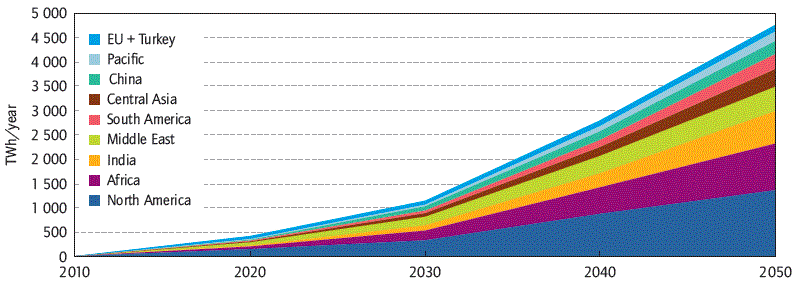OECD/IEA(2010): Technology
Roadmap Concentrating Solar Power. 49p.
『集光太陽パワー(太陽熱発電・熱利用)技術ロードマップ』
Table of contents
Foreword 1
Table of contents 3
Acknowledgements 4
Key findings 5
Key actions by government in the next ten years 5
Introduction 7
Rationale for CSP 7
The purpose of the roadmap 8
Roadmap process, content and structure 8
CSP status today 9
The importance of the solar resource 9
Current technologies for power production 11
Enhancing the value of CSP capacities 13
Grid integration of CSP plants 16
Plant cooling and water requirements 17
CSP for niche markets 17
Vision of future deployment 19
Existing scenarios and proposals 19
CSP deployment 19
The vital role of transmission 20
Deployment till 2020: intermediate and peak loads 21
Deployment till 2030: base loads and CO2 reductions 22
Deployment beyond 2030: power and fuels 23
Economic perspectives 27
Operation and maintenance costs 28
Costs of providing finance for CSP plants 28
Generating costs 28
Towards competitiveness 28
Milestones for technology improvements 31
Troughs and LFR 31
Towers and dishes 32
Improvements in storage technologies 33
Emerging solar fuel technologies 33
Policy framework: roadmap actions and milestones 35
Overcoming economic barriers 35
Financing innovation 35
Incentives for deployment 36
Addressing non-economic barriers 36
Research, development and demonstration support 36
Collaboration in R&D and deployment 37
Deployment in developing economies 38
Conclusion and role of stakeholders 41
Units, acronyms, abbreviations and references 43
Foreword
Current trends in energy supply and use are patently unsustainable
. economically, environmentally and socially. Without decisive
action, energy-related emissions of CO2 will more than double
by 2050 and increased oil demand will heighten concerns over the
security of supplies.
We must - and can - change our current path; we must initiate
an energy revolution in which lowcarbon energy technologies play
a lead role. If we are to reach our greenhouse-gas emission goals,
we must promote broad deployment of energy efficiency, many types
of renewable energy,
carbon capture and storage, nuclear power and new transport technologies.
Every major country and sector of the economy must be involved.
Moreover, we must ensure that investment decisions taken now do
not saddle us with suboptimal technologies in the long term.
There is a growing awareness of the urgent need to turn political
statements and analytical work into concrete action. To spark
this movement, at
the request of the G8, the International Energy Agency (IEA) is
developing a series of roadmaps for key energy technologies. These
roadmaps provide solid analytical footing that enables the international
community to move forward, following a well-defined growth path
. from today to 2050 . that identifies the technology, financing,
policy and public engagement milestones needed to realise the
technology’s full potential. The IEA
roadmaps include special focus on technology development and deployment
to emerging economies, and highlight the importance of international
collaboration.
The emerging technology known as concentrating solar power, or
CSP, holds much promise for countries with plenty of sunshine
and clear skies.
Its electrical output matches well the shifting daily demand for
electricity in places where airconditioning systems are spreading.
When backed up by thermal storage facilities and combustible fuel,
it offers utilities electricity that can be dispatched when required,
enabling it to be used
for base, shoulder and peak loads. Within about one plants that
emit high levels of CO2. The sunniest regions, such as North Africa,
may be able to export surplus solar electricity to neighbouring
regions, such as Europe, where demand for electricity from renewable
sources is strong. In the medium-tolonger term, concentrating
solar facilities can also produce hydrogen, which can be blended
with natural gas, and provide low-carbon liquid fuels for transport
and other end-use sectors.
For CSP to claim its share of the coming energy revolution, concerted
action is required over the next ten years by scientists, industry,
governments, financing institutions and the public. This roadmap
is intended to help drive these indispensable developments.
Nobuo Tanaka
Executive Director

Figure 2: Solar resource for CSP technologies (DNI in kWh/m2/y)
Source: Breyer & Knies, 2009 based on DNI data from DLR-ISIS
(Lohmann, et al. 2006).
Table 1: The four CSP technology families
|
Receiver type\Focus type |
Line focus
Collectors track the sun along a single axis and focus irradiance
on a linear receiver. This makes tracking the sun simpler. |
Point focus
Collectors track the sun along two axes and focus irradiance
at a single point receiver. This allows for higher temperatures. |
Fixed
Fixed receivers are stationary devices that remain independent
of the plant’s focusing device. This eases the transport of collected
heat to the power block. |
Linear Fresnel Reflectors |
Towers (CRS) |
Mobile
Mobile receivers move together with
the focusing device. In both line focus and point focus designs,
mobile
receivers collect more energy. |
Parabolic Troughs |
Parabolic Dishes |

Figure 5: Growth of CSP production under four scenarios (TWh/y)

Figure 6: Growth of CSP production by region (TWh/y)
OECD/IEA(2010)による『Technology
Roadmap Concentrating Solar Power』から |
ホームへ


